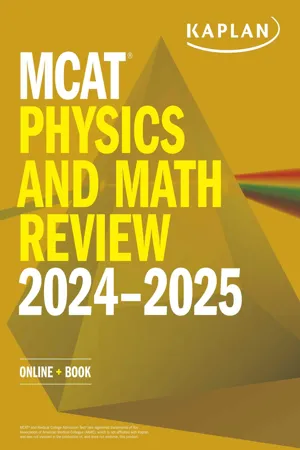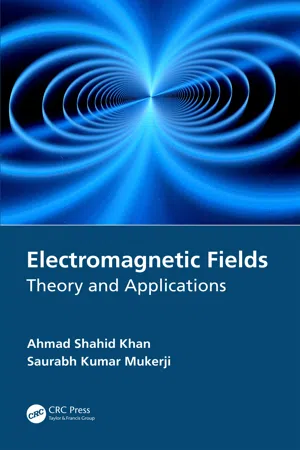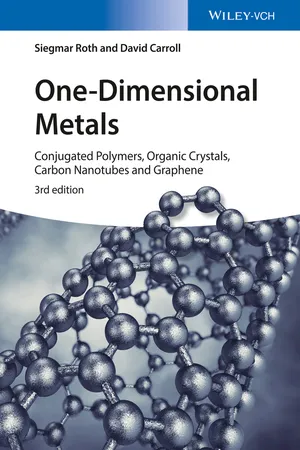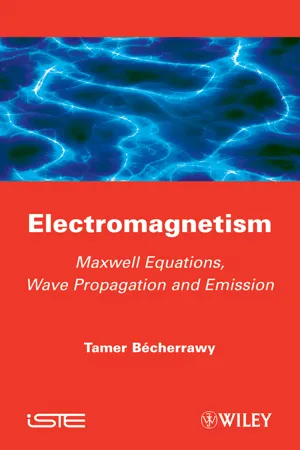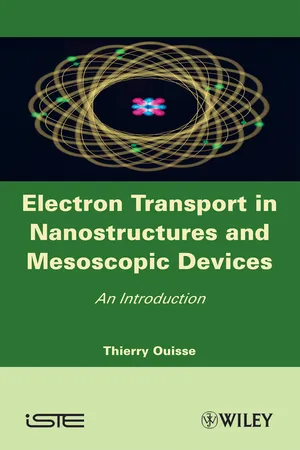Physics
Conductance
Conductance refers to the measure of a material's ability to conduct electric current. It is the reciprocal of resistance and is represented by the symbol G. Conductance is influenced by factors such as the material's composition, temperature, and dimensions, and is an important concept in understanding the flow of electricity in various systems.
Written by Perlego with AI-assistance
Related key terms
Related key terms
1 of 4
Related key terms
1 of 3
7 Key excerpts on "Conductance"
- Peter Kissinger, Peter T. Kissinger, William R. Hieneman, William R. Heineman, Peter Kissinger, William R. Heineman(Authors)
- 2018(Publication Date)
- CRC Press(Publisher)
In this chapter we take a careful look at the phenomenon of electrical conductivity of materials, particularly electrolytic solutions. In the first section, the nature of electrical conductivity and its relation to the electrolyte composition and temperature is developed. The first section and the second (which deals with the direct-current contact methods for measuring Conductance) introduce the basic considerations and techniques of Conductance measurement. This introduction to Conductance measurements is useful to the scientist, not only for electrolytic Conductance, but also for understanding the applications of common resistive indicator devices such as thermistors for temperature, photoconductors for light, and strain gauges for mechanical distortion. The third section of this chapter describes the special techniques that are used to minimize the effects of electrode phenomena on the measurement of electrolytic Conductance. In that section you will encounter the most recent solutions to the problems of conductometric measurements, the solutions that have sparked the resurgent interest in analytical conductometry.I. SOME BASIC RELATIONSHIPSA material exhibits the property of electrical conductivity when it contains charged particles that are free to move through the material. When an electrical potential is applied across such a material, the charged particles will experience a force along the field in a direction opposite to their charge. The resulting net motion of the charged particles is an electric current. The greater the current produced by a given electric field, the greater the conductivity of the material. Since conductivity is related to the rate of flow of charge in response to an electric field, the magnitude of the conductivity is dependent on the concentration, mobility, and charge of the charged particles. In this section, the relationship between the conductivity and the mobility, charge, and concentration of the charged species is developed. Finally, the property of conductivity is related to the measured parameter, Conductance.A. ConductivityWhen a charged particle i (an electron or ion) in a liquid or solid material is subjected to an electric field, it quickly reaches a limiting average velocity of motion in the direction of the field opposite to the sign of its charge. The velocity vi (cm/s) is given byv i=u iε(8.1) where is the particle’s mobility and ε is the electric field strength (V/cm). The resulting electric current density (Ji in C/s-cm2 ) is given byJ i=v iN iq i(8.2) where Ni is the number of i particles per cubic centimeter and qi is the coulombic charge on each particle. Note that the sign of vi will change with the sign of qi- No longer available |Learn more
MCAT Physics and Math Review 2024-2025
Online + Book
- (Author)
- 2023(Publication Date)
- Kaplan Test Prep(Publisher)
This chapter reviews the essentials of circuits. From this broad knowledge base, we will draw on specific topics within circuit theory: conductivity, electromotive force (emf), resistance, power, Kirchhoff’s laws, resistors, capacitors, meters, and series and parallel arrangements of circuit components. As you encounter the concepts of this chapter and the equations associated with them, remember this: the MCAT approaches the topic of circuits with a greater emphasis on the concepts than on the math. You will be expected to calculate, say, the equivalent resistance for resistors in series or parallel, but the circuits you encounter on Test Day will, on the whole, be simpler than what you may have seen in your college physics class.6.1 Current
LEARNING OBJECTIVES
After Chapter 6.1, you will be able to:- Recall the definitions of current, voltage, electromotive force (emf), and conductivity, and the SI units for each
- Compare the conductivity of two solutions, given their component ions
- Describe the relationship between voltage sources and voltage drop
- Use Kirchhoff’s laws to describe the flow of electrons through a circuit
In the last chapter we examined the behaviors of still charges, but in most cases we are interested in the movement of charge, or current. Because of historical conventions, current is considered the flow of positive charge—even though only negative charges are actually moving. Any conductive substance may act as a medium through which current can pass.Conductivity
Conductivity can be divided into two categories: metallic conductivity, as seen in solid metals and the molten forms of some salts, or electrolytic conductivity, as seen in solutions. Conductance is the reciprocal of resistance, a property we will examine in detail later. The SI unit for Conductance is the siemens (S), sometimes given as siemens per meter(for conductivity.S m)Metallic Conductivity
Some materials allow free flow of electric charge within them; these materials are called electrical conductors. Metal atoms can easily lose one or more of their outer electrons, which are then free to move around in the larger collection of metal atoms. This makes most metals good electrical and thermal conductors. The metallic bond - eBook - ePub
Electromagnetic Fields
Theory and Applications
- Ahmad Shahid Khan, Saurabh Kumar Mukerji(Authors)
- 2020(Publication Date)
- CRC Press(Publisher)
:R =Lσ S(8.20b) The electrical conductivity , σ has the unit of Siemens per meter. The reciprocal of conductivity is called the (electrical ) resistivity or specific electrical resistance of the material. It is measured in Ohm-meters. In some cases, a quantity called Conductance is found to be quite useful. It is denoted by letter G and is the reciprocal of resistance R . It can thus be given as:G =1 R=σ SL(8.20c) Equation 8.20a is another form of Ohm’s law. This law involves terms V (the potential difference in volts), I (the current in ampères), and R (the resistance in ohms). These terms are commonly used in circuit theory. This law states that the current is directly proportional to the potential difference between two ends (across) of a material, called a resistor (or any other ohmic device). Non-linear materials with conductivity varying with the current through or voltage across it do not obey Ohm’s law.Equation 8.20b is also a well-known relation which gives the value of resistance in terms of the area of cross-section “S” (in square meters) and length “L” (in meters) of the conductor and the electrical conductivity “σ ” or the electrical resistivity “(1/σ )” of the material. Resistivity and conductivity are reciprocal. Resistivity is defined as a measure of the material’s ability to oppose the flow of electric current. From Equation 8.20b, it can be concluded that the resistance of a conductor depends on the material and its dimensions. For a given material, the resistance of a conductor is inversely proportional to the cross-sectional area and directly proportional to the length.While deriving the above relations, the current density is assumed to be totally uniform in the conductor which can be taken as true in most of the practical situations. This condition prevails in linear materials such as metals, and under low frequencies. In the case of alternating current, these relations do not yield the true value of resistance due to skin effect and proximity effect which are briefly described below. Further description of these effects is included after the introduction of inductance in Chapter 14 - eBook - ePub
Solid State Quantum Information — An Advanced Textbook
Quantum Aspect of Many-Body Systems
- Vlatko Vedral, Wonmin Son(Authors)
- 2018(Publication Date)
- WSPC (EUROPE)(Publisher)
Chapter 2
Electrical Conductivity in Solid
Electrical conductivity is a measure of a material’s ability to conduct an electric current. When an electrical potential is placed across a conductor, its movable charges flow is giving rise to an electric current. Solids that can carry the electric current have atoms with outer electrons and the electrons are free to move throughout the entire length of the material. The phenomena of electrical conductivity have explained by several different models and they had provided various levels of understanding. They had applied classical, semiclassical theories and theories with first quantized and second quantized versions.We start with simplest classical model of electrical conductivity which is still good for basic understanding. However, the theory is limited so that they had failed to explain the other phenomena in a solid and it had been overcome by more elaborated theories. It is quantum theory which has successfully explained them with consistency.2.1.Classical (Drude) Model
In 1900, Paul Drude proposed a model of electrical conductivity in a metallic material. The model explains the transport properties of electrons in metals with an assumption that the microscopic behavior of electrons in a solid may be treated as classical motion of point particles. The dynamics of electron resembles a pinball machine as like sea of balls bouncing and rebouncing in the lattices that is composed of heavier, relatively immobile positive ions. In the model, several assumption had been made for the matter of simplification and they are as follows: - eBook - ePub
One-Dimensional Metals
Conjugated Polymers, Organic Crystals, Carbon Nanotubes and Graphene
- Siegmar Roth, David Carroll(Authors)
- 2015(Publication Date)
- Wiley-VCH(Publisher)
Chapter 6 Conducting Polymers: Conductivity6.1 General Remarks on Conductivity
The section on conductivity of any textbook usually starts with Ohm's law6.1where I is the current, U is the voltage, and the proportionality constant R is the resistance. The reciprocal of the resistance is the Conductance. Not all conductors obey Ohm's law. Gas discharges, vacuum tubes, and semiconductors often deviate from Ohm's law, as do most of the one-dimensional conductors discussed in this textbook. When resistivity or conductivity values are quoted, the current or voltage range has to be specified where these values were obtained.In an Ohmic material, the resistance is proportional to the length l of the sample and inversely proportional to the sample cross section A:6.2where ρ is the resistivity, measured in Ω cm. Its inverse is the conductivity (ρ−1 = σ). The unit of the Conductance is Siemens (S). Siemens is the reciprocal of Ohm and sometimes is written as Ω−1 , or mho (ohm backward). The unit of conductivity is S/cm (in SI units, m should be used rather than cm; in publications, both m and cm are common and attention must be paid to the figure and table captions).In many solids, σ depends on the crystallographic direction and hence is not a scalar quantity but a tensor. Such solids are said to have an anisotropic conductivity. The combination of high conductivity in one direction and zero conductivity in the two perpendicular directions leads to one-dimensional solids (see the anisotropy approach in Section 1.2 ). In kalium (potassium) tetracyanoplatinate (KCP) (Section 2.2 ), the conductivity parallel to the platinum chains is about 200 times larger than the conductivity in the perpendicular direction [1]; in SbF5 -intercalated graphite, the conductivity within the ab-plane can be up to 1 × 106 times that of the c-direction [2]. The anisotropy of “highly conducting stretch-aligned polyacetylene” has been determined as - eBook - ePub
Electromagnetism
Maxwell Equations, Wave Propagation and Emission
- Tamer Becherrawy(Author)
- 2013(Publication Date)
- Wiley-ISTE(Publisher)
semiconductors (silicon, germanium, tellurium, etc.). Their resistivity depends strongly on the impurities they contain (small amounts of foreign atoms that are introduced into the semiconductor).3.8. Resistance of conductors
Experimental studies starting with Ohm in 1826 showed that each segment of a conductor has a characteristic quantity, known as the resistance R, such that the drop in the potential between its ends is related to the current by Ohm's law[3.49]The SI unit of R is the volt/ampere, called ohm (Ω). R depends on the material and the geometrical form of the conductor, on the impurities that it contains, and its temperature. Ohm's law applies to a variety of conductors said to be Ohmic. A plot of V versus I (called characteristic) for an Ohmic conductor is a straight line passing through the origin with a slope R (Figure 3.11a ). In other words, for such materials, R (defined as V/I) is independent of I (or V) and, if the potential difference is reversed, the current through the conductor is reversed without change of intensity. Metals are almost Ohmic, but there are many conductors that are not (see Figure 3.11b and 3.11c ). An ionized gas, a diode, etc., are non-Ohmic. Connection wires of reasonable length have usually a very small resistance and a conductor that serves to introduce a resistance in the circuit is called resistor. The dissipated power in the conductor of resistance R is[3.50]To see how the resistance depends on the shape of a conductor, let us consider a cylindrical wire of uniform cross section S and length L with the potential V applied between its ends. The conservation of electric charge implies that the current intensity is the same at any point of the wire and, if the section is uniform and the current density is uniform over the cross section, the current density j = I/S is the same everywhere in the conductor. On the other hand, the translational symmetry implies that the electric field E has the same magnitude along the wire; thus, using the local form of Ohm's law E = ρj, we find V = EL = ρjL = (ρL/S)I. This corresponds to a resistance R = ρL/S - eBook - ePub
Electron Transport in Nanostructures and Mesoscopic Devices
An Introduction
- Thierry Ouisse(Author)
- 2013(Publication Date)
- Wiley-ISTE(Publisher)
Chapter 3Ballistic Transport and Transmission Conductance
3.1. Conductance of a ballistic conductorElectrical resistance characterizes the energy dissipation imposed upon the carriers when they pass through a device under the action of an electric field. It reflects the power lost in the device. Usually, when we want to study the transport properties of a macroscopic conductor, or a device which is not mesoscopic, we expect the resistive contribution of the device active layer to represent a non-negligible part of the overall measured resistance, and most often to be the prevailing part. Even if the contacts between the metal pads and the sample exhibit a susbtantial resistance value, we can get rid of it by using four-probe measurements, in which we pass the current through some terminals and we measure the voltage from the others. Then we obtain something which is not zero, which depends on the resistivity value of your sample and which scales with the device length according to Ohm’s law. Now suppose that we want to measure the transport properties of a really small device, in which the electrons are truly ballistic. If nothing impedes the electron passing through the device we might expect the device resistance to go down to zero, and not to depend on the device length any longer. In addition, even if the Conductance was scaling inversely with the device length following Ohm’s law, we might also expect the measured Conductance to continuously increase as we reduce the device length. However, this is not the case. In fact, if we continuously reduce the resistance of something, we can expect that sooner or later the active layer resistance must become smaller than the contact resistance, which we need to link the small device to the macroscopic wires. Thus, we can expect that after a substantial enough reduction of device length, all the losses are due to the contact rather than to the “device” itself. We shall investigate this point in the case of quantum, ballistic devices, and we shall see that this picture actually fits the reality: we cannot observe a vanishing resistance, and dissipation occurs at the contact between the ballistic sample and the rest of the circuit; however, the Conductance itself is still fixed by the ballistic device properties! When the Conductance does not scale with length, it is no longer appropriate to define a conductivity, and the Conductance must be calculated through the probability for an electron impinging at the device boundary to be transmitted through the device to the opposite terminal. This is not so new a feature if we have already calculated the tunneling current through a square barrier. We already know that for such a device the resistance is all but proportional to the barrier length. However, it took a certain number of years for physicists to be accustomed to the fact that it was the correct approach in the case of mesoscopic and ballistic devices. This field of research has greatly benefited from the theoretical ideas and concepts put forth by, among many others, P.W. Anderson, R. Landauer and M. Büttiker. However, as for any other solid-state physics topics, advances could not have been obtained without a huge progress in technological processes and experimental work. The formulae expressing the Conductance as a function of the transmission probabilities are called the Landauer-Büttiker formalism.
Index pages curate the most relevant extracts from our library of academic textbooks. They’ve been created using an in-house natural language model (NLM), each adding context and meaning to key research topics.
Explore more topic indexes
Explore more topic indexes
1 of 6
Explore more topic indexes
1 of 4

